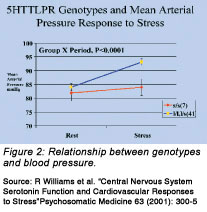|
by Redford B WILLIAMS

 n age-old poser goes like this: Does nature or nurture dictate our thoughts, behaviour, or health? The answer: both. n age-old poser goes like this: Does nature or nurture dictate our thoughts, behaviour, or health? The answer: both.
Studies of identical (monozygotic, or MZ) and fraternal (dizygotic, or DZ) twins have long shown that genes significantly determine many traits — or phenotypes. That is, these traits correlate about twice as strongly in MZ twins, who have the same genetic makeup, as in DZ twins, who share half their genes. These same studies, however, also show that the environment, which either is common to the twins or is unique to each, also plays an important role in determining individuals’ traits.
The only time genes are the sole determinant of a given trait is when one gene gives rise to that trait, most often a disease such as sickle-cell anaemia and Huntington’s Chorea. If someone has the copy of the gene causing the disease, he or she is going to get it, regardless of the environment. Of course environmental factors can speed or delay the onset of disease, but ultimately those with the sickle-cell gene or the Huntington’s gene will come down with the disease.
Twin studies can only tell us what percentage of a phenotype — whether physical like blood-pressure reactions to acute stress, mental like the tendency towards depression, or behavioural like aggression — is determined by one’s genetic makeup and the environment in which one lives. Understanding more fully how genes and environment actually interact to make people who and what they are requires knowledge of which specific genes are involved in regulating a specific phenotype under study and how variation in those genes affects the phenotypes. With the completion of the sequencing of the human genome in the Human Genome Project, researchers can now study how variations in specific genes interact in specific environmental circumstances to affect specific phenotypes.
Humans have about 30,000 different genes, give or take a thousand or so. To understand how genes and environment interact to affect phenotypes that might raise the risk for disease, knowing which gene to study becomes the important issue and knowing the biology underlying the phenotypes of interest becomes critical.
The neurotransmitter serotonin regulates in the brain and in bodily tissues and organs many physical and psychological phenotypes of interest to those studying the role of psychosocial factors in health and disease. Serotonin plays a key role in the brain by regulating negative emotions (sadness, anger, and anxiety) and behaviours such as eating, drinking alcohol, and smoking. Brain serotonin helps regulate the sympathetic nervous system and hormonal responses to stress responsible for surges in adrenalin and cortisol that cause the heart to race and blood pressure to rise in the presence of stress.
Therefore, much of the work aimed at identifying genes implicated in stress responses affecting both physical and mental health has focused on genes that regulate serotonin in the brain and elsewhere. One such gene makes the serotonin transporter, the molecule responsible for the reuptake and hence termination of the action of serotonin released from nerve endings. The serotonin-transporter gene has a variant (polymorphism) with two forms, or alleles — long and short. The long allele makes twice as much transporter protein as the short one.
Science published a paper in 2003 about Avsholam Caspi and his colleagues’ study of the relationship between stressful life events and depression development in a group of men and women whom they had identified as having serotonin-transporter-gene polymorphism. Figure 1 shows that those who had two copies of the long allele were relatively immune to the effects of stressful events whereas those with two copies of the short allele were far more likely to become depressed in the face of stress.
 Gene–environment interaction takes place over an extended period. As the number of stressful life events increases, so does the likelihood of depression, but the impact of events on depression risk varies greatly according to one’s genotype on the serotonin-transporter gene. With no stressful events, persons of all genotypes have roughly a 10% risk of depression; with more events, the risk rises modestly, up to 17%, in those with two long alleles, but jumps to over 40% in those with two short alleles. Gene–environment interaction takes place over an extended period. As the number of stressful life events increases, so does the likelihood of depression, but the impact of events on depression risk varies greatly according to one’s genotype on the serotonin-transporter gene. With no stressful events, persons of all genotypes have roughly a 10% risk of depression; with more events, the risk rises modestly, up to 17%, in those with two long alleles, but jumps to over 40% in those with two short alleles.
 In addition to chronic gene/environment interaction, it is also possible to see acute interaction that occurs more dynamically. Psychosomatic Medicine in 2001 published our work at Duke University, US that found that the blood pressure of people with one or two copies of the long-allele serotonin transporter did not differ from those with two copies of the short allele when they were sitting quietly and resting. However, when subjected to an acute stressor — such as recalling a situation that had made them angry — those with one or two long alleles showed a much greater blood-pressure increase than those with the short/short (s/s) genotype (Figure 2). In addition to chronic gene/environment interaction, it is also possible to see acute interaction that occurs more dynamically. Psychosomatic Medicine in 2001 published our work at Duke University, US that found that the blood pressure of people with one or two copies of the long-allele serotonin transporter did not differ from those with two copies of the short allele when they were sitting quietly and resting. However, when subjected to an acute stressor — such as recalling a situation that had made them angry — those with one or two long alleles showed a much greater blood-pressure increase than those with the short/short (s/s) genotype (Figure 2).
Depending upon the situation one finds oneself in, then, the transporter genotype can have no effect on blood pressure (when subject rests quietly) or a great effect (when subject experiences acute mental stress). This effect of the long allele to magnify the blood-pressure response to acute stress could have an important impact on one’s risk of developing heart trouble. Other work has shown that people with larger blood pressure responses to acute mental challenge are more likely to suffer heart attacks as well as to show progression of arteriosclerosis. In addition, recent research in both Europe and Japan has found that people with the long allele are more likely to suffer heart attacks than those with two short alleles.
These examples illustrate how genes and environment interact in both the short and the long term to affect such negative traits as depression or to increase the risk of developing such health problems as heart disease.
Ultimately, using knowledge about how genes and environment interact in raising the risk of disease can guide doctors in identifying those for whom preventive measures might be taken. For instance, if a behavioural intervention that teaches heart patients how to manage anger better also reduces both depression and blood pressure surges during angry episodes, intervention might be effective in improving prognosis in patients at risk.
For more information contact Redford Williams at redfordw@duke.edu
 Click here to download the full issue for USD 6.50 Click here to download the full issue for USD 6.50
|



 n age-old poser goes like this: Does nature or nurture dictate our thoughts, behaviour, or health? The answer: both.
n age-old poser goes like this: Does nature or nurture dictate our thoughts, behaviour, or health? The answer: both.
 Gene–environment interaction takes place over an extended period. As the number of stressful life events increases, so does the likelihood of depression, but the impact of events on depression risk varies greatly according to one’s genotype on the serotonin-transporter gene. With no stressful events, persons of all genotypes have roughly a 10% risk of depression; with more events, the risk rises modestly, up to 17%, in those with two long alleles, but jumps to over 40% in those with two short alleles.
Gene–environment interaction takes place over an extended period. As the number of stressful life events increases, so does the likelihood of depression, but the impact of events on depression risk varies greatly according to one’s genotype on the serotonin-transporter gene. With no stressful events, persons of all genotypes have roughly a 10% risk of depression; with more events, the risk rises modestly, up to 17%, in those with two long alleles, but jumps to over 40% in those with two short alleles.
 In addition to chronic gene/environment interaction, it is also possible to see acute interaction that occurs more dynamically. Psychosomatic Medicine in 2001 published our work at Duke University, US that found that the blood pressure of people with one or two copies of the long-allele serotonin transporter did not differ from those with two copies of the short allele when they were sitting quietly and resting. However, when subjected to an acute stressor — such as recalling a situation that had made them angry — those with one or two long alleles showed a much greater blood-pressure increase than those with the short/short (s/s) genotype (Figure 2).
In addition to chronic gene/environment interaction, it is also possible to see acute interaction that occurs more dynamically. Psychosomatic Medicine in 2001 published our work at Duke University, US that found that the blood pressure of people with one or two copies of the long-allele serotonin transporter did not differ from those with two copies of the short allele when they were sitting quietly and resting. However, when subjected to an acute stressor — such as recalling a situation that had made them angry — those with one or two long alleles showed a much greater blood-pressure increase than those with the short/short (s/s) genotype (Figure 2).
 Click here to download the full issue for USD 6.50
Click here to download the full issue for USD 6.50